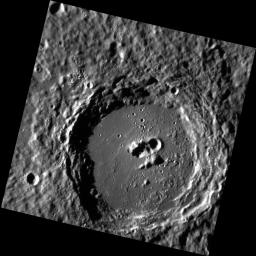
|
Ups and Downs
- Click the image above for a larger view
- Full-Res JPEG (1229 x 1230) (179.1 kB)
- Full-Res TIFF (1229 x 1230) (1.5 MB)
Caption:
Today's image features Neruda crater, named for the Chilean poet Pablo Neruda. The crater exhibits several central peaks punctuated by a more recent, small crater, resulting in a rugged profile of ups and downs if one were to traverse the crater floor. Similarly, the crater's namesake Neruda experienced a number of ups and downs in his life, from success as a poet, through poverty, war and ultimately alleged poisoning.
This image was acquired as a high-resolution targeted observation. Targeted observations are images of a small area on Mercury's surface at resolutions much higher than the 200-meter/pixel morphology base map. It is not possible to cover all of Mercury's surface at this high resolution, but typically several areas of high scientific interest are imaged in this mode each week.
Date acquired:
July 24, 2012
Image Mission Elapsed Time (MET):
251577944
Image ID:
2256593
Instrument:
Narrow Angle Camera (NAC) of the Mercury Dual Imaging System (MDIS)
Center Latitude:
-52.20°
Center Longitude:
125.3° E
Resolution:
142 meters/pixel
Scale:
Neruda crater is 112 km (69 mi) in diameter
Incidence Angle:
80.4°
Emission Angle:
2.4°
Phase Angle:
78.0°
Background Info:
The MESSENGER spacecraft is the first ever to orbit the planet Mercury, and the spacecraft's seven scientific instruments and radio science investigation are unraveling the history and evolution of the Solar System's innermost planet. MESSENGER acquired over 150,000 images and extensive other data sets. MESSENGER is capable of continuing orbital operations until early 2015.
For information regarding the use of images, see the MESSENGER image use policy .
Cataloging Keywords:
| Name | Value | Additional Values |
|---|---|---|
| Target | Mercury | |
| System | ||
| Target Type | Planet | |
| Mission | MESSENGER | |
| Instrument Host | MESSENGER | |
| Host Type | Orbiter | |
| Instrument | Mercury Dual Imaging System (MDIS) | |
| Detector | Narrow Angle Camera (NAC) | |
| Extra Keywords | Crater, Grayscale, Map, Radio | |
| Acquisition Date | ||
| Release Date | 2013-09-30 | |
| Date in Caption | 2012-07-24 | |
| Image Credit | NASA/Johns Hopkins University Applied Physics Laboratory/Carnegie Institution of Washington | |
| Source | photojournal.jpl.nasa.gov/catalog/PIA17515 | |
| Identifier | PIA17515 | |
